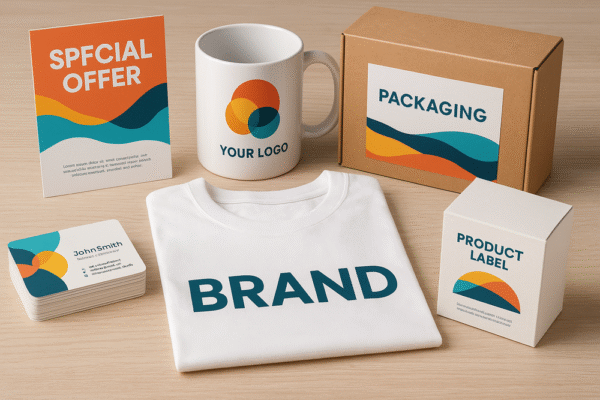The Future of Printing in Africa: Trends and Innovations

See how digital printing, sustainable packaging, 2D barcodes, personalization, print-on-demand, and AI are reshaping the future of printing in Africa. Today, Africa’s print landscape is moving fast. As e-commerce business model is expanding, mobile internet penetration is also deepening across the continent.
As packaging regulations tighten, printing has also shifted from a back-office function to a frontline growth driver for SMEs, NGOs, and enterprise brands. The future belongs to businesses and developers that blend technology, creativity, and sustainability in their products and services —and that’s exactly where JaraPrint operates.
This industry research is designed to unpack the African print market context, featuring the 10 most important innovative trends, and a practical roadmap to help strengthen your brand’s strategy in Africa. As a leading online printing platform, we offer custom printing solutions combined with advanced technology, premium materials, and pan-African delivery network to help businesses grow with confidence.
The Market Context: Why printing in Africa is Set for Rapid Growth
1. Mobile adoption is booming.
According to GSMA projects, there are nearly 700 million unique mobile subscribers in Sub-Saharan Africa by 2030, with approximately 226 million 5G connections (17% adoption). More connectivity equals more digital-to-physical touchpoints (I.e. increase use of QR codes and Augmented Reality on packaging, flyers, or banners; Print on Demand services, and hyper-local print delivery). (event-assets.gsma.com)
2. E-commerce keeps rising.
UNCTAD finds that e-commerce business sales rose from 60% (2016–2022) to $27T globally, indicating a structural shift toward digital-enabled trade that also increases the need for packaging, inserts, return labels, and last-mile materials such as print resources, tools, or printed items. (UN Trade and Development (UNCTAD))
3. Packaging is a growth engine.
The Africa packaging market is estimated at $45.15B in 2025 and projected to reach $54.54B by 2030—a strong anchor market for print providers, suppliers and brands. (Mordor Intelligence)
4. Logistics are improving (but varies).
The World Bank’s LPI global highlights in 2022, it took about 44 days for goods to move from the port where they were exported to the port where they arrived. Most of this delay came from how long shipments were held up at the importing country’s port. This is an important factor for African e-commerce businesses and for managing printed stock and delivery timelines.
5. Regulation is tightening on plastics and waste.
Many African countries are regulating plastic wastes due to node gradable packaging and environmental impact. For example, Kenya’s nationwide plastic bag ban (2017) set a regional tone; the South Africa made Extended Producer Responsibility (EPR) for packaging mandatory in 2021; and Nigeria is advancing EPR-based plastic packaging rules—accelerating demand for recyclable, clearly labeled, and intelligent packaging. (nema.go.ke, Forestry, Fisheries & Environment, UNEP – UN Environment Programme)
Bottom line: Africa’s print future is digital, sustainable, data-driven, and closely integrated with e-commerce and mobility. Now, here are innovative printing trends in Africa.
10 Trends & Innovations Shaping Africa’s Printing Future
1. Digital Printing is Now the Default for Fast Delivery
Unlike the traditional offset, digital printing is now the smartest option for short runs, quick turnarounds, and personalization—perfect for startups and SMEs that need fast, localize products. Globally, digital print keeps expanding as brands demand speed and on-demand flexibility. (Grand View Research)
Where JaraPrint fits:
- We offer business essentials like business-cards, flyers and posters, banners and signage on fast cycles.
- Including rapid prototyping and small-batch pilot prints before big rollouts.
2. Sustainable Packaging is now “Non-Negotiable”
African governments are aligning their policies with a circular global economy.
- The Kenya’s plastic bag ban (2017) has created a decisive shift toward eco-friendly options.
- The South Africa’s EPR regulations (effective 2021) formalize producers’ responsibility for packaging waste, pushing design for recycling and recycled content.
- Nigeria is also developing EPR rules for plastic packaging with UNEP support—pointing to rapid changes ahead for brands selling in West Africa.
Today, global consumer sentiment has favored greener packaging choices and this is the new reality. (McKinsey & Company)
Where JaraPrint fits:
- We offer recyclable cartons, labels, and eco inks via our packaging and product labels.
- We ensure compliance-ready labeling and material guidance for multi-country distribution.
3. Custom Packaging can be a Revenue Multiplier
Packaging is now a sales tool and a storytelling canvas for many global players. It drives shelf standout, improves unboxing, and boosts perceived value for a brand. As Africa’s retail and direct-to-consumer (D2C) channels expand, SKU-specific packaging and seasonally refreshed or updated packaging becomes a competitive lever.
Where JaraPrint fits:
- We offer high-impact labeled boxes, wrappers, sleeves, and stickers.
- Events or product launch kits and limited offers for promos or influencer packs.
- Ensure inventory tracking, accurate labeling, and customer clarity.
4. Connected Packaging: QR, Data, and GS1’s 2D
The transition to 2D barcodes (QR/Data Matrix) is underway globally. GS1’s “Sunrise 2027” aims for POS systems that can scan 2D by the end of 2027, enabling richer data (ingredients, batch, expiry), traceability, and direct consumer engagement from the pack. (GS1 US, GS1 US Documents)
Why this matters in Africa:
- Smartphones are the default screen; thus QR-led journeys from pack to web/app are intuitive.
- 2D codes streamline recalls, returns, and multilingual compliance without confusing.
Where JaraPrint fits:
- We design QR/GS1-ready artworks + variable data on labels or flyers.
- Campaign flows that connect packaging to microsites like fundraise and loyalty.
- See our design-services.
5. Personalization at Scale with Variable Data Printing (VDP)
VDP lets you change text, images, or codes per unit printed item—ideal for targeted offers, donor letters, event badges, access cards, serialized labels, or language localization. Globally, the use of VDP labels are growing fast, driven by e-commerce and customization.
Where JaraPrint fits:
-
Name-level invites, segmented offers, serial/anti-counterfeit codes, badge numbers and geo-localized versions for regional rollouts.
6. Print-on-Demand (POD) is Unlocking Cash-Flow Efficiency
Why overprint and store? POD model has reduced the inventory storage risk, enabling micro-batches, and supports cross-border e-commerce. In Middle East & Africa, print-on-demand revenue is projected to grow at 20–23% CAGR into the 2030s, reflecting creator-economy momentum and SME adoption. (Grand View Research)
Where JaraPrint fits:
- We offer POD on arts prints, branded apparel and promotional gifts.
- Marketing inserts and packaging designed, printed and delivered just-in-time.
7. E-Commerce x Logistics: Designing for Print Fulfillment
As more African shoppers buy online, brands need shipping-ready packaging, robust labels, and returns workflows. The World Bank notes import-side processes (dwell time) cause the biggest variability in delivery reliability—so planning print quantities and inventory buffers matters.
Where JaraPrint fits:
- Shipper boxes, tamper seals, return labels, inserts that “feel premium” at the door.
- Scale-smart quantities (avoid stockouts without locking cash in warehouses).
8. 3D Printing for Prototyping and Fast Innovation
Across Africa, additive manufacturing is beginning to gain tractions for prototyping parts, packaging mockups, and even construction/education pilots (e.g., 3D-printed classrooms in Malawi). South African institutions document additive manufacturing as a strategic capability for design speed and customization. (World Economic Forum, aisi.csir.co.za)
Where JaraPrint fits:
-
We offer rapid mockups (structural packaging dummies), visual proofs, and small fixtures to accelerate go-to-market.
9. AI-Accelerated Design & Content Operations
today, creative operators are being transformed by AI tools (layout, copy variants, image generation, and background removal). Industry surveys have shown widespread adoption by creative professionals and marketing teams, with AI now considered as an essential investment rather than an experiment. (Adobe Blog, Canva)
Where JaraPrint fits:
-
We use brand-safe templates, AI-assisted design varianting, and human QA where applicable to ensure on-brand outputs before print.
10. Intelligent, Interactive Packaging & AR
“Connected packaging” is expanding beyond QR to Augmented Reality (AR try-ons), NFC taps, and serialized experiences. Research indicates growing market adoption for AR packaging, which uses printed materials to trigger immersive content—great for cosmetics, beverages, and premium FMCG.
Where JaraPrint fits:
-
Marker-based AR layouts, QR + GS1 Digital Link, and packaging that unlocks post-purchase engagement.
5 Predictions or Growth Forecasts for the Next 5–10 Years
-
2D codes become standard on African retail packs, enabling real-time product data, authentication, and loyalty.
-
Sustainable substrates and EPR compliance become a top procurement criterion across Nigeria, South Africa, Kenya, and Ghana.
-
VDP everywhere: serialized labels, micro-targeted offers, and language/geography variants become default.
-
POD normalizes for D2C fashion, creators, and event brands; cross-border micro-exports grow.
-
AI-driven creative ops compress time-to-market; humans focus on strategy, storytelling, and QA.
Conclusion
The Future of Printing in Africa: Trends and Innovations
The future of printing in Africa is connected, sustainable, and data-driven. Brands that embrace digital print, eco-ready packaging, 2D barcodes, VDP, and POD will win on agility and trust—while AI and 3D tools compress the journey from idea to market.
Ready to build your next-gen print stack?
-
Explore eco-ready packaging.
-
Launch connected collateral.
-
Scale merch & inserts with POD.
JaraPrint helps African businesses print smarter and sell more. Contact us now for free consultation.
Innovative Printing trends in Africa FAQs
1) Is Africa’s print market really growing?
Yes—packaging demand is expanding, while e-commerce and mobile adoption keep creating new use cases for printed materials.
2) What’s the big deal about 2D barcodes?
By 2027, global POS systems are expected to scan 2D codes, enabling richer data, traceability, and consumer engagement from packaging.
3) How do new packaging rules affect me?
Expect stronger EPR and plastics policies. Kenya already banned plastic bags; South Africa mandates EPR; Nigeria is moving toward EPR enforcement—so recyclable materials and clear labeling will matter more.
4) Is personalization worth it?
Yes. VDP labels and mailers are growing globally thanks to e-commerce and segmentation—great for offers, events, and anti-counterfeiting.
5) How does POD help SMEs?
POD reduces cash tied in inventory and lets you test designs fast. MEA POD is projected to grow ~20%+ CAGR into the 2030s.
About JaraPrint
JaraPrint is Africa’s largest print-on-demand marketplace, connecting customers with trusted local printers, designers, and delivery partners. From business cards, flyers to T-shirts, wall arts, packaging, and signage, we make it easy to order or sell high-quality printed products online - fast, reliable and affordable.




